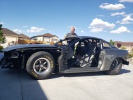
Originally Posted by
ccline746pk

4.7,
So I get the timing now, I understand the HVAC will make it spkie down and I did look back and the long events where it was at -10 were when the tps was zero. I am so green right now, up to this point my mechanical abilities have been limited to carburetors so im just trying to understand how the system is supposed to work. So in your first post you say "The second screen shot is from the engine running too lean." I understand I need to change the overall AFR to 14.1:1. I am sure I know where to do that.
Second, I will clean the MAF.
Third, I will double check the fuel pressure but I think it should be fine as I replaced the pump and filter in the past year.
Fourth, can you explain your statement, "fuel trims should be much more neutral." When it comes to the charts right now they are greek to me. Is there a good tutorial you can point me to? For the fuel trims, LT, ST etc. And for the spark table as well for that matter. I can use a timing light and twist a distributor like nobody business but Im struggling here.....
Thanks again,
Chris





 Reply With Quote
Reply With Quote